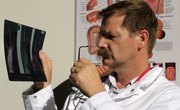Education in radiology trains graduates to perform digital imaging, such as magnetic resonance imaging or MRI and x-ray services, through hospitals, clinics and doctor's offices. According to the U.S. Bureau of Labor Statistics, this field will expand more rapidly than many others through 2020, offering good employment opportunities. An associate degree is needed to enter the field and a certificate in radiology builds on that base.
Courses
An associate degree includes general education courses, so students working toward an AS in radiology need to take classes in areas such as composition, social studies, humanities and physical education in addition to algebra and physiology. Certificate programs usually focus only on the skills specific to radiology. Both plans teach students aspects of the job such as radiology basics, patient care, ethics and legal aspects of healthcare, safety in radiology and procedures. Certification programs may focus on one particular type of imaging, such as MRI.
Admission
Like most associate degree programs, radiologic technology programs generally require students to be high school graduates, but they also need a strong math and science background. In contrast, certificate programs often build on previous schooling or experience rather than taking the place of the basic degree. For instance, applicants to the University of North Carolina Chapel Hill's program must already have an associate degree and those applying to the Austin Community College District's MRI certification program must already be certified in another area of radiology.
Time and Cost
Since an associate degree consists of more classes than a certificate, it usually takes longer and costs more. The associate degree takes about two years to complete, which may include coursework or clinical experience over the summer. Certificate programs typically run about two semesters, although they may take as long as the associate degree in some cases. AS radiology degrees consist of about 70 credits, so they are more expensive than most certification programs, which may require as few as 15 credits. Specific costs vary depending on the school.
Licensing
Workers in the radiography field typically need to obtain a license or certification according to their state's requirements. The primary certifying body, The American Registry of Radiologic Technologists, will require a minimum of an associate degree as of January, 2015, a change put into place to create more well-rounded and effective technologists. Because of this demand, new students in the field should aim for an associate degree in radiology first, followed by further certification in a particular area.
Related Articles
References
- U.S. Bureau of Labor Statistics: Radiologic Technologists
- Community College of Allegheny County: Radiologic Technologist (X-Ray) Associate's Degree
- Lorain County Community College: Radiologic Technology Program Questions and Answers
- University of North Carolina Chapel Hill: Certificate in Radiography
- Austin Community College District: MRI Program
- American Registry of Radiologic Technologists: Academic Degree Requirement Effective 2015 for Primary Certification
Writer Bio
Kristie Sweet has been writing professionally since 1982, most recently publishing for various websites on topics like health and wellness, and education. She holds a Master of Arts in English from the University of Northern Colorado.











